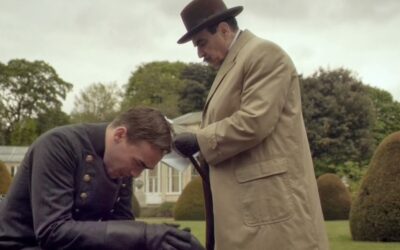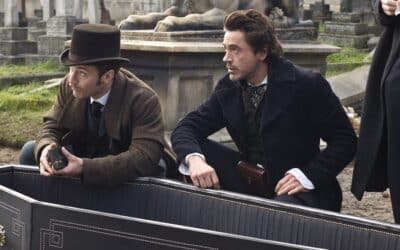
Feature
Elements of a PI Novel
K.R. Hill
I read PI books because I want intrigue, action, and suspense. I want to rub shoulders with scary characters without getting too close. I know the genre and find that familiarity comforting, as though coming home to an old friend.
However, not every PI novel puts it all together. Many times, when I finish a promising whodunnit, I’m left feeling unsatisfied. Something was missing. I had wanted the book to have more. But what is the more? What are the elements that make a great PI novel?
To answer that, I dissected three highly successful works, each from a different era: The Hound of the Baskerville’s (1902), In the Electric Mist with Confederate Dead (1993), and The Girl with The Dragon Tattoo (2005). And yes, I know the latter is not a classic PI novel, but the title character works as an investigator, so I’m using the book.
In each novel I found that setting permeates the work. It dictates weather, dialogue, and the food the characters eat. Therefore, setting has to be the first element. Whether it is the mist-shrouded Scottish moors of Hound, the Cajun swamps of Electric, or the cold brick mansions of rural Sweden in Girl, each novel has a fantastic setting that lured me into the story, made me want more, like a smile from across a barroom.
After re-reading each book, I learned that the second element of a great PI novel is to have a memorable bad guy. I’m talking Hannibal Lector or Voldemort. If a novel in this genre is going to rise above the masses and take flight, the reader has to worry about the safety of the hero. Worry creates suspense, and that keeps the reader turning pages. The greater the challenge, the greater the suspense.
In Hound, for example, Holmes might get his throat ripped out by a hideous beast. In Electric, the bad guy is a fat, sweaty mob boss known for leaving enemies impaled on meat hooks, and our hero might be hooked next. In Girl, the investigator is fighting a serial killer so cleaver as to have eluded justice for 40 years.
Of course, if a book has a tremendous villain, it has to have a fantastic investigator. The trick is to match the hero to the villain, like pairing wine to an entrée. And on rare occasion, a writer takes this pairing to new heights by creating a villain/hero/heroine combo so dynamically opposed that sparks seem to fly off the page. When handled correctly, this pairing becomes an enjoyable literary device used to create conflict and suspense.
Think about these examples: To the highly cultured, intellectual Sherlock Holmes, the writer pairs him with a wild, hideous beast. Perfect. I’m already worried about Sherlock.
In Electric, our hero is Dave Robicheaux, a cop fighting every second to suppress a legendary temper, and his need for alcohol. He’s a time-bomb about to explode. To compliment that investigator, the author gives us a psychopathic mob boss who loves to torture people. It’s the perfect pairing, the perfect set-up. I was just waiting for Dave Robicheaux to explode.
What about the heroine in Girl? you ask. Well, I have, in my opinion, saved the best for last. Picture the cold, scrubbed daily mansions of rural Sweden where much of the book takes place. What type of heroine should the author pair against this tight-lipped, refined wealth? Enter Lisbeth Salander, black hair cut in a 4” spiked mohawk, clad in biker leather with a ring through her nose and 13 more in each ear. What a stunning dichotomy. This villain/heroine pairing is as shocking as every aspect of the book, therefore perfectly suited.
An important part of creating a believable hero, is to make them human by showing their weaknesses. We see Sherlock Holmes’ addiction to cocaine, and how, in between cases, he slips into depression. Dave Robicheaux struggles with anger management and alcoholism. The more I learned of Lisbeth Salander in Girl, the more I wanted to help her. Revealing hero/heroine weaknesses to the reader makes the reader feel closer to the character, like getting to know a new buddy.
Now it’s time to wrap up. But wait, you say, how can you not mention plot? Well, I’ve made plot the last element because if the writer creates a fantastic setting, a legendary villain paired against a dynamically opposed hero, then only a simple plot is needed for a great book.
In Hound, a relative is murdering family members so that he can inherit a fortune.
In Electric, a cop tries to find out who is killing local prostitutes.
And in Girl, a journalist is hired to solve a 40-year-old murder.
But wait! I can hear you shouting. Those books have much more complicated plots than you mention.
Let me clarify. The plot of each novel is the case. It is the reason we are reading. Someone committed a crime. Another person (hero/heroine/PI) is trying to find out who committed the crime. Story, on the other hand, is everything happening around the characters that is not directly related to the case.
About the Author
K.R. Hill began writing adventure stories at the age of six. Soon he had every boy in the neighborhood coming to his house after school as he created Sinbad the Sailor adventures and led his crew to rescue many a beautiful princess.
His creative abilities caught the attention of a book-loving grandmother. She read him the classics, and often told him that the greatest writers were those that had grabbed life by the horns, she’d say with a Texas twang.
Due to his grandmother’s influence, K.R. Hill left college and traveled until his need to create began to call. When he could no longer ignore the call, he moved into a sand-filled, abandoned house beside the Caribbean. There he daily spearfished and clanked out his first novel on a manual typewriter while spraying Bug and Tar Remover at mosquitoes.
He now has two-thirds of a private investigator trilogy in print, with the third book due before Christmas. He also has a mystery/action novel, a book of travel tales, and two nonfiction books on the market.
Some time ago he traded his wandering ways and portable typewriter for a settled life and a computer. He now writes with the love of his beautiful wife and the support of a big rescue dog.

More Detective Features
The Characteristics of Hercule Poirot
Peculiar habits and unmatched deductive abilities
Detective Novels
The pinnacle of sleuthing
The Best of Sherlock Holmes
Four Sherlock Holmes Mysteries You Need to Read



